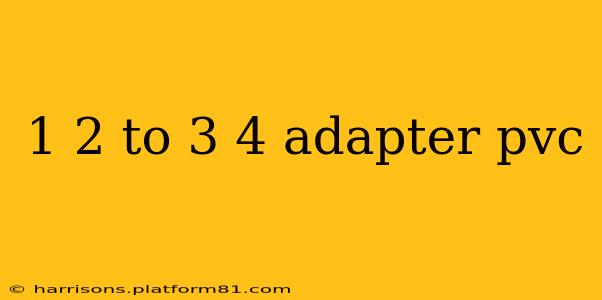Finding the right PVC adapter can be tricky, especially when dealing with different pipe sizes. This guide focuses specifically on the common need for a 1 1/2" to 3/4" PVC adapter, explaining its uses, types, and installation. Whether you're a seasoned plumber or a DIY enthusiast tackling a home project, understanding these details is crucial for a successful and leak-free installation.
What is a 1 1/2" to 3/4" PVC Adapter?
A 1 1/2" to 3/4" PVC adapter is a connecting fitting used to join two PVC pipes of different diameters—specifically, a 1 1/2-inch diameter pipe to a 3/4-inch diameter pipe. These adapters are essential for plumbing systems where different pipe sizes are required, allowing for a smooth transition between them. They are typically made of rigid polyvinyl chloride (PVC), known for its durability, resistance to corrosion, and affordability.
Types of 1 1/2" to 3/4" PVC Adapters
Several types of adapters can accomplish this size transition:
-
Reducer Bushing: This is the most common type. It's a simple fitting with a 1 1/2" socket on one end and a 3/4" male pipe thread on the other. This allows for connection to either a female threaded fitting or a glued PVC pipe.
-
Reducer Coupling: This type has a 1 1/2" socket on one end and a 3/4" socket on the other. Both ends are glued to the corresponding pipes.
-
Eccentric Reducer: This type offsets the smaller diameter pipe slightly relative to the larger one. This is useful in situations where perfect alignment is difficult to achieve.
-
Concentric Reducer: This type features a straight, centered reduction from the larger to the smaller diameter. This is suitable for most applications where precise alignment isn't a major concern.
What are the Applications of a 1 1/2" to 3/4" PVC Adapter?
These adapters are versatile and find use in various plumbing applications, including:
-
Connecting different sized pipes: This is the primary use, allowing for a seamless transition between different pipe sizes within a system.
-
Repairing existing systems: When replacing a section of pipe, an adapter may be necessary to connect the new pipe to the existing one.
-
Modifying existing systems: Adapters allow for changes to be made to existing plumbing layouts without significant rework.
-
Irrigation systems: They can be used to connect smaller sprinkler lines to larger main lines.
-
Water supply lines: They are often used in household plumbing where the main supply line might be larger than individual fixture connections.
How to Install a 1 1/2" to 3/4" PVC Adapter?
Proper installation is crucial to prevent leaks. Always follow these steps:
-
Prepare the pipes: Ensure both the 1 1/2" and 3/4" pipes are cut cleanly and square. Deburr the ends to remove any sharp edges that could damage the adapter or cause leaks.
-
Apply PVC primer and cement: Apply a thin, even coat of PVC primer to both the pipe ends and the inside of the adapter sockets.
-
Apply PVC cement: Apply a thin coat of PVC cement to the primed surfaces. Avoid using too much cement, as it can weaken the bond.
-
Insert the pipes: Carefully insert the pipes into the adapter sockets, twisting slightly to ensure a complete bond.
-
Hold the pipes: Hold the pipes firmly in place for the recommended time specified on the PVC cement packaging to allow the cement to cure properly.
Note: Always refer to the manufacturer's instructions for your specific PVC cement and adapter.
What are the Different Materials Used for 1 1/2" to 3/4" PVC Adapters?
The vast majority of these adapters are made from schedule 40 or schedule 80 PVC. Schedule 80 PVC offers greater pressure resistance compared to schedule 40. The choice depends on the application and the pressure requirements of the plumbing system.
How Do I Choose the Right 1 1/2" to 3/4" PVC Adapter?
The choice of adapter depends mainly on the specific needs of your plumbing project. Consider the following:
-
Type of connection: Do you need a threaded or glued connection?
-
Pipe type: Ensure the adapter is compatible with the type of PVC pipe you are using (e.g., schedule 40 or 80).
-
Alignment needs: If precise alignment is critical, an eccentric reducer might be necessary.
This comprehensive guide offers valuable information for anyone working with 1 1/2" to 3/4" PVC adapters. Remember to always prioritize safety and follow the manufacturer's instructions for optimal results.
